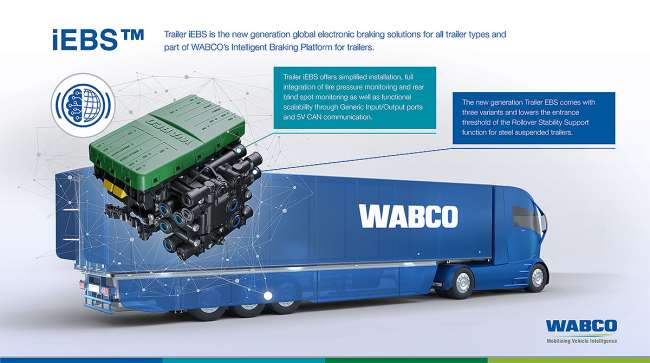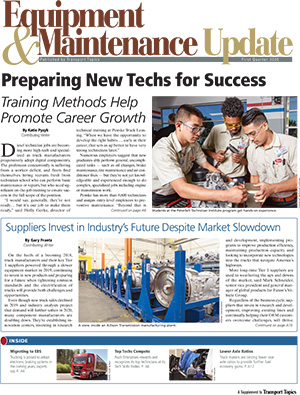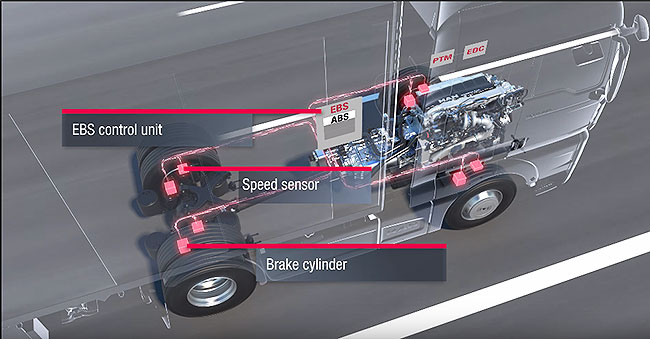Contributing Writer
Electronic Braking Systems Expected to Gain Traction

[Stay on top of transportation news: Get TTNews in your inbox.]
After two decades of use in Europe, electronic braking systems will make significant inroads in the North American commercial vehicle market in the coming years to support the development of driver-assist technology and electric trucks, some industry experts said.
Representatives from brake suppliers Bendix, Meritor and Wabco use the same general time frame when discussing how quickly the technology could be adopted here.
“Within three to five years, we see EBS coming to the U.S. in larger scale,” said Thomas Dieckmann, Wabco’s innovation and technology officer.

- Preparing New Technicians for Service
- Electronic Braking Systems Expected to Gain Traction
- Suppliers Invest in Industry's Future Despite Market Slowdown
- Technician Career Development: An Endless Journey
- LEDs Represent Future of Truck Headlamps
- Rear-Axle Ratios Are Still Moving Downward
- Tractor-Trailers at a Tipping Point
In fact, he said “island applications” are already in use in the United States involving vehicles with 24-volt architecture and those not carrying trailers. Also, the technology is being used in some buses.
Bendix Commercial Vehicles Systems also estimates EBS will be commonplace in three to five years and has been testing the technology in the United States for the past couple of years, said Mike Tober, director for electronic brake and chassis control. Bendix currently has no North American truck manufacturer customers releasing a product outfitted with EBS. However, some buses and specialty vehicles imported from Europe incorporate the technology.
Meritor’s Joseph Kay, director of engineering, described the three- to five-year time frame as a goal. He pointed out that some regulations must be updated, while those dealing with backup strategies must be written. SAE International test procedures also must be updated.
Chris Stadler, product marketing manager for Volvo Trucks, expects adoption to occur along a three- to eight-year timetable, in part because of the challenge of training inspectors.
Many steps remain to be taken before EBS achieves widespread adoption, said Jack Legler, technical director for American Trucking Associations’ Technology & Maintenance Council. Those include developing prototypes, track testing, verifying reliability and integrating with advanced driver assistance systems, or ADAS. Legler said an electronic braking system must be “absolutely flawless” before it can enter the market.

EBS diagram by Man Truck & Bus via YouTube
“You can’t degrade safety performance,” he said. “It’s got to be at least as good or better to be both desirable and have the regulatory people allow it and have industry acceptance at the driver level. … We’re not going to go backwards on risk.”
Industry experts said longhaul fleets, which generally operate in the most predictable environments, will adopt the technology first. Vocational heavy-duty trucks operate in smaller volumes in harsher environments, where fleets must tailor their equipment to fit the application.

Newhouse
Scott Newhouse, chief engineer for Peterbilt, said regional and medium-duty haulers also could be early adopters if they incorporate electric powertrains.
Bendix’s Tober expects linehaul trucks to be the first to use the systems.
“However,” he said, “sometimes the market takes strange turns, and a specialized application could move up in priority as the OEs go through their product planning cycles.”
EBS differs from traditional anti-lock braking systems, or ABS, in that braking is controlled electronically rather than pneumatically, or by air. The driver applies the brakes, and the system calculates necessary actions for brake management. A brake signal transmitter replaces the foot valve and sends an electronic signal to the controller, which then signals braking needs to each axle group. The electronics system knows what the driver wants, calculates vehicle mass and calculates the pressure needed at the wheel ends.
Traditional pneumatic systems remain in place with EBS, so there’s redundancy, said Bendix’s Tober. Compressed air is used to apply the brakes, so if there’s an electrical failure, the brakes still function.
The shift is poised to occur in North America because of the rapid adoption of ADAS and the growth of electric vehicles, Bendix’s Tober said. ADAS require communication across the entire vehicle. EBS allows for smoother, faster braking and improved brake balance across various applications. EBS works better with collision avoidance systems than ABS. It also can be integrated into vehicle-to-vehicle communications and platooning.
“EBS knows, by design, how much pressure it takes to achieve a certain deceleration — it’s being calculated and is learning all the time,” Meritor’s Kay said.
Meanwhile, EBS is almost a necessary technology for electric vehicles because it integrates with the regenerative braking process in which power is captured and returned to the vehicle.
“If you want to have that optimal energy recuperation together with the best possible stability, you’d better choose EBS,” Wabco’s Dieckmann said.
ABS has gradually been evolving into EBS, Meritor’s Kay said. Stability control previously wasn’t an option with ABS; now it’s mandatory for tractors, and it can calculate mass. Other features such as “hill hold” have been integrated into ABS. ABS upgrades have handled automated functions such as stability and collision mitigation.
However, “That ABS system is trending toward the end of its time in the market and is likely not capable of supporting the new trends pulling us into the next generation of braking,” he said.
As with any new technology, EBS will require technicians to learn and adjust, but Bendix’s Tober doesn’t expect the transition to be too challenging because most brake parts will remain the same. EBS predictive maintenance capabilities will detect and warn about impending failures. Technicians will be able to track brake lining wear, increasing uptime. Moreover, Tober said EBS is easier to install than ABS.
Meritor’s Kay expects the impact on truck maintenance to be “low overall” because the transition is occurring after the industry has adopted other complex electronic systems.
Peterbilt’s Newhouse said EBS’ more precise control of brake applications to each wheel can reduce brake wear.
Among the challenges will be communicating between tractors and trailers. Drivers might have to hook up the communications network cable each time they attach to a trailer. Carriers will have to match new EBS to much older trailers.
In part one of a two-part exploration of autonomous technology today, our latest RoadSigns podcast revisits conversations with CEOs Alex Rodrigues of Embark and Cetin Mericli of Locomation. Hear them explain what testing automated trucks and developing platooning technology has taught them about the road ahead — and get new perspective with host commentary. Listen to a snippet from Rodrigues above, and to hear the full episode, go to RoadSigns.TTNews.com.
“You’re going to have purely mechanical trailers out there for years even with EBS, so that you have to worry about how an electronic braking system in a tractor, for example, is going to interface with a 25-year-old trailer, because that’s exactly what happens every day,” TMC’s Legler said.
European fleets have enjoyed the benefits of EBS for two decades. Volvo’s Stadler said EBS is more responsive than traditional ABS. The process moves faster electronically than it does when waiting for the air to flow through the system and apply the brake. It also supports functions such as driver assist, which prevents the truck from rolling backward and forward.
EBS also reduces complexity. Valves and piping are replaced with software functionality that allows technicians to identify issues and improve diagnostics. EBS works better with telematics systems, allowing fleets to better monitor trucks and predict when problems could occur.
In Europe, carriers operate with an electronic interface with the trailer, Wabco’s Dieckmann said. The technology allows the tractor-trailer combination to decelerate up to a second earlier compared with a conventional system.
EBS also can be easily altered to meet a fleet’s needs.
“The EBS system has the ability to change the performance characteristics with a ‘keystroke,’ ” Meritor’s Kay said. “Essentially by hooking a laptop to the vehicle system, certain features may be adjustable.”
Peterbilt’s Newhouse said adapting the technology here will require manufacturers to integrate it into North American braking architectures. U.S. trucks have a different weight distribution than European ones.
Wabco’s Dieckmann said the systems and logic for the North American market will be like those used in Europe, but the parts will be adapted for lower U.S. voltage.
“All the OEs are now global,” TMC’s Legler said. “All the braking system suppliers are global. Nobody’s thinking about this U.S. market. Everybody’s thinking global market as they’re developing these new technologies.”
Given EBS’ advantages and widespread use in Europe, why has it taken so long to gain a foothold in North America?
Bendix’s Tober said the primary market drivers of automation and electric power haven’t been a major factor here until recent years.
Wabco’s Dieckmann said EBS was introduced in the European market based on benefits such as constant brake-pedal feeling along with brake pad wear harmonization. The technology helps ensure front and rear pads wear at about the same rate. But those arguments were not persuasive to U.S. customers, he said.
Want more news? Listen to today's daily briefing:



